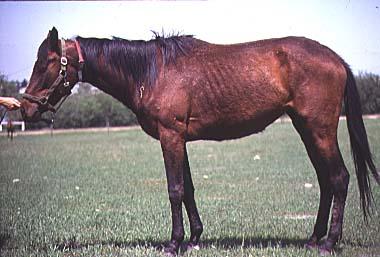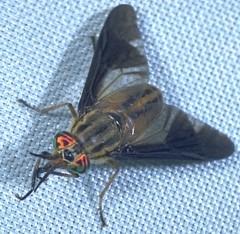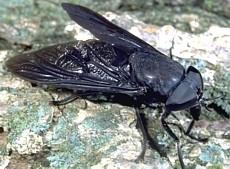Equine Infectious Anemia
Equine Infectious Anemia
Author: Fernanda C. Camargo, Department of Animal and Food Sciences
Introduction

Equine Infectious Anemia (EIA) is characterized by recurrent episodes of fever, lethargy, inappetence (lack of appetite) and anemia (low red blood cell count). The virus that causes EIA is a lentivirus and is closely related to the Feline Immunodeficiency Virus (FIV) and the Human Immunodeficiency Virus (HIV), among other diseases. All lentiviruses cause persistent infections, most of which are slowly progressive disease leading to death. However, EIA infections result in an acute phase, during which the horse shows fever and signs of anemia, followed by recurrent clinical disease episodes that, in most horses, eventually subside. These horses become permanently infected, and most of the time they are inapparent carriers of the virus. Another characteristic of the EIA virus is that it is a retrovirus. Because retroviruses lack proofreading ability, a number of mutations occur with each replication. Therefore, during the course of infection, a number of viral variants will develop, and each horse will be infected with one of these mutant variants. One horse can be infected with more than one variant of the virus as well. HIV also replicates in this manner, which is one of the reasons why researchers have not been able to develop a vaccine against either HIV or EIA.
Prevalence
EIA is a worldwide disease of horses and other equids (donkeys, mules, ponies, and zebras). It is transmitted mostly by insect vectors, making it more prevalent in warm climates. In the United States, EIA has been more prevalent in the Gulf Coast region. In the early 1970s, the Coggins test was developed, which became the basis for the EIA control program implemented by the United States Department of Agriculture (USDA) in 1972. As a result, the prevalence of EIA has been consistently declining since that time. In 2003, the prevalence of EIA in the United States was reported as 0.01%. However, this percentage does not reflect the EIA prevalence in the general horse population because it is biased by repeated testing, year after year, of high-quality horses competing in events that require negative test results and those entering exhibitions, traveling, at auction, etc. Only 25% of the U.S. horse population is estimated to be tested every year, so it is impossible to know the true prevalence of EIA in the United States.

Photo courtesy of Dr. Lee Townsend
Transmission
EIA is transmitted from an infected horse to another horse via contaminated blood. The transfer of blood by blood-feeding insects is the main means of natural transmission. The insects serve as mechanical vectors only, transferring blood in their mouthparts. The most important insects in the transmission of EIA are horseflies and deerflies. Mosquitoes do not transmit EIA.
Several factors are important for EIA transmission by insects. For example, horses with a high amount of virus in their blood (high viremia) and presenting clinical signs of disease are more likely to transmit EIA than inapparent carriers with low levels of virus in their blood.

Photo courtesy of Dr. Lee Townsend
Behavior of feeding insects also plays an important role. For example, for transmission to occur, an insect needs to feed from an infected horse, be interrupted in that feeding, and then, within a short period of time, find and feed on another horse. Horseflies are not able to transmit EIA if the subsequent feeding does not occur within four hours. Horseflies and deerflies have a painful bite that contributes to their efficiency as vectors because the horse interrupts their feeding with defensive movements, so the insect often moves on to another horse. The distance between the infected horse and the other susceptible horses is another important factor in transmission. When a horsefly or deerfly feeds off a horse and is interrupted, it will return to the same horse 99% of the times if the other horses are over 160 feet away.
A mare can transmit EIA to the foal in utero, during parturition (foaling), or through the colostrum or milk. Th transmissions are more likely to occur if the mare develops acute clinical disease and viremia during gestation.
Finally, EIA can also be transmitted through transfusion of contaminated blood and by the use of blood-contaminated instruments, such as surgical or tattooing instruments, dental equipment, needles, and so forth.
Clinical Signs
EIA can cause a variety of clinical signs, which include fever, lethargy, inappetence, thrombocytopenia (low platelet count in the blood), anemia, splenomegaly (enlarged spleen), hepa tomegaly (enlarged liver), weight loss, edema (swelling), and hemorrhage. The severity of the disease will depend upon the viral load, the virulence of the virus (the strength of the particular virus strain), and the susceptibility of the horse. Therefore, severity will vary from horse to horse.
The three clinical stages of EIA infection are acute, chronic, and inapparent. Th acute stage occurs after initial infection. Five to 30 days after exposure, viremia can occur, leading to fever, thrombocytopenia, lethargy, and inappetence. These signs can be mild and may not even be noticed by the owner. The fever will usually subside in a few days, although a small percentage of horses develop high viremia and severe anemia, a combination that can be fatal. After the initial acute stage of the disease, most horses experience recurrent episodes of the acute clinical phase, characterized by viremia, fever, lethargy, inappetence, thrombocytopenia, and anemia. Each episode is caused by a different, mutated, virus. Clinical episodes last three to five days, and the interval between episodes ranges from weeks to months. The infected horses appear normal between episodes. If these recurrent episodes become frequent and severe, the horse develops signs of chronic EIA. These include weight loss, swelling of the legs, and anemia. The horse with chronic EIA will have pale mucous membranes and may develop epistaxis (nosebleed). However, in the majority of horses, the recurrent episodes last for about a year, after which the horses become inapparent carriers. These horses look normal, and because they have very low plasma viral loads, the risk of transmission from these carriers, though possible, is low. These horses are infected for life, and environmental stress can induce a clinical episode.
Diagnosis
Several tests are approved by the USDA for diagnosis of EIA. They include the agar gel immunodiffusion (AGID) test, also known as the Coggins test, and three ELISA (enzyme-linked immunosorbent assay) tests. The Coggins test is very specifi but not very sensitive. Therefore, it can lead to false negative results if the viral load is low. The ELISA tests are very sensitive but less specific than the Coggins (AGID) test, which can lead to false positive results. Therefore, when a horse is deemed positive by one of the ELISA tests, the results need to be confirmed with the AGID test. Other tests exist but are not sanctioned by the USDA.
Treatment and Prevention
There is no specific therapy for EIA infection. This disease is reportable, and federal law prohibits the interstate transport of infected horses. If an owner chooses to keep the horse alive, treatment will include isolation from other horses, non-steroidal anti-inflammatory drugs for the fever, leg wraps for the swelling, and blood transfusion for severe anemia.
Since there is no vaccine to prevent EIA infection, prevention is achieved through removal of the infected horse from the population. Humane euthanasia is the most common method of removal. Horses that are not euthanized must be permanently identified with a brand or lip tattoo applied by a USDA representative, after which an infected horse may be quarantined on the premises with a 200-yard separation distance from all other horses. The horse and premises will be monitored periodically to ensure that the provisions are not being violated. The infected horse can also be moved to a federally approved research facility.
Other methods to prevent infection include the annual testing of horses, the testing of horses as part of a pre- purchase evaluation, testing of blood and plasma donors, no sharing of the same syringe and needle between horses, and proper sterilization of dental and surgical equipment, between procedures. Finally, vector control in your property will minimize the transmission of EIA to susceptible horses.
References
Mealey, R.H. Equine Infectious Anemia. In Equine Infectious Diseases, Eds: Sellon, D.C., Long, M.T. Saunders Elsevier, Saint Louis, Missouri, pp 213-219, 2007.
Sellon, D.C. and L.N. Wise. Disorders of the Hematopoietic System—Equine Infectious Anemia Virus. In Equine Internal Medicine, 3rd ed. Eds: Reed, S.M., Bayly, W.M., Sellon, D.C. Saunders Elsevier, Saint Louis, Missouri, pp 741-742, 2010.
